In this post I have reviewed and compared four popular 8-person air tents against each other. These four happen to be the vis-a-vis type 8-person air tents, where you have a symmetrical design: the bedrooms face each other, enclosing a living space at the middle of the tent.
The 8-person air tents reviewed in this post are the;
The 8-person tunnel tents, like the Coleman Weathermaster 8XL, or the Outdoor Revolution Ozone 8.0 will not be discussed here.
The Best 8-person Air Tent
You obviously want to know, which 8-person air tent is the best, so I created a scoring system. As any scoring system, it is as fair as it can be, but it really is just an indication of which one may be at the top of the league, and which one you should probably avoid if you want to spend your money wisely.
The categories in which I compete them against one another are:
Each receives a point according to their rank in each category, the winner / best buy will be one with the least point.
Summary
Vango Longleat II 800XL Air
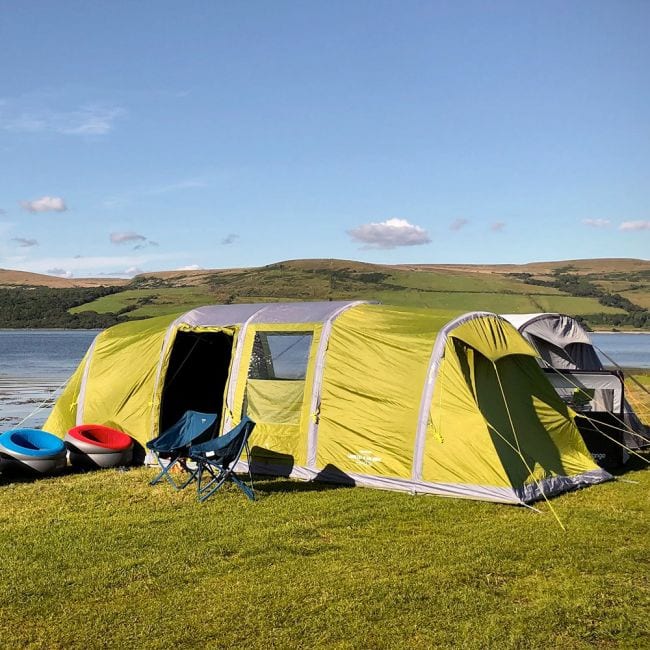
The Vango Longleat II 800 XL scored 7 points across 4 categories, coming in at a steady 1st or 2nd place everywhere. In other words: this tent is not large, but it makes it less bulky. There’s just enough communal area, and there’s just enough sleeping space for 8.
The weather protection is great, but it’s still a budget tent.
If you don’t want to buy a Eurohike Genus 800, this is your second cheapest option. There are still a few compromises you’ll have to make; however, it depends on how many people will stay in this tent.
|| Buy it at Winfields Outdoors ||
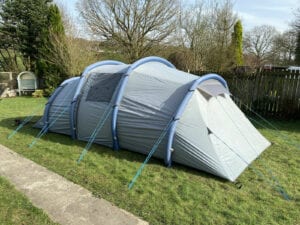
Eurohike Genus 800
Eurohike Genus 800
The Eurohike Genus 800 is the cheapest of the 4. The sleeping area is just as big as the Vango Longleat’s but the living area is second to none. The fabrics are thin and cheap, the groundsheet is toggled, and the entire tent is rather small; yet, it makes it easier to carry and faster to pitch.
It scored 8 points across the 4 categories. The Eurohike Genus 800 is not a bad tent (and it’s not just ‘considering it’s price‘), but it does not provide the luxurious feel that others might do.
It is also barely an 8-person air tent: despite that 8 person might be able to sleep in it, the living area only serves the function of leaving the boots in front the bedroom. There’s just enough space for eight pairs, but nothing more.
I could more easily imagine a family of 4 or 5 in the Eurohike Genus 800, rather than 8 adults.
|| Buy it at GoOutdoors ||
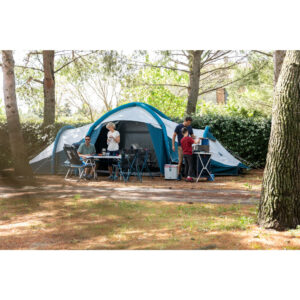
Quechua Air Seconds 8.4 Fresh & Black
Quechua Air Seconds 8.4 F&B
Scored 10 points, the Quechua Air Seconds 8.4 came in 3rd. It is only marginally more expensive than the Vango Longleat II 800XL, yet it is much bigger. The most consideration / hesitation has to be around the loose groundsheet: if you don’t mind having a loose groundsheet I would definitely recommend the Quechua over the Vango.
Apart from that, the Quechua Air Seconds 8.4 F&B is a brilliant tent: great design, feels huge thanks to its internal height yet it is easy to pitch. It provides great weather and storm protection too, and thanks to the 5-year warranty, it could be a great companion for many years to come.
|| Buy it at Decathlon ||
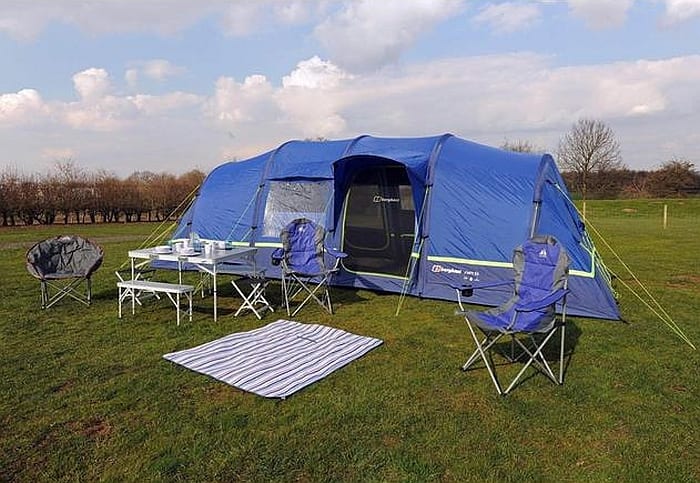
Berghaus Air 8
Berghaus Air 8
Quite surprisingly the Berghaus Air 8 scored 11 points, leaving it at the 4th place of this little league table. Yes, it’s large, but it’s also extremely bulky and heavy, takes longer to pitch and it’s the most expensive on this list.
It does not mean that the Berghaus Air 8 is a bad tent or that I would not recommend it. The overall picture is quite good I believe, and Berghaus air tents have been known to be very solid and reliable family air tents. But looking at it detail by detail, there is always one that’s better, lighter or cheaper.
On the other hand, it also means, that the Berghaus Air 8 is the one with the least compromise and it is a great all-rounder. Although it is the most expensive on this list, the Berghaus Air 8 is still one of the cheaper 8-person air tents, staying well below the £1000 mark.
|| Buy it at Millets ||
Detailed Comparison
Transport & Pitching
The clear winner of this section is the Eurohike Genus 800, hugely because it is smaller than the others, thus lighter, easier to handle and erect.
The Berghaus Air 8 comes in 4th, because it is the largest and the heaviest. So, in my opinion, the final order would look like this:
- Eurohike Genus 800
- Vango Longleat II 800 XL Air
- Quechua Air Seconds 8.4 F&B
- Berghaus Air 8
Vango Longleat II 800XL Air
The Vango Longleat II 800XL air tent comes in a L80.0 x H43.0 x W43.0cm carrybag and weighs 22.6 kgs. This is really impressive, considering the size of the tent, and it makes transporting the tent slightly easier: the massive bag would likely take up the majority of the boot space of your car, but at least one person can carry it. A carrybag of this size is unlikely to fit in any roofbox.
As for pitching, the Vango Longleat II 800 XL air tent features 5 pre-angled Vango AirBeams with AirSpeed valves, and there’s a dual action pump included in the pack to inflate all 5 of them. With practice, a 20 minute pitching time is more than realistic.
Eurohike Genus 800
The Eurohike Genus 800 is smaller than the rest of the air tents in this comparison, which gives it the edge when it comes to weight, transport and pitching.
Firstly, the Eurohike Genus 800 fits into a 73 x 38 x 36cm carrybag and it weighs only 12.8 kgs. This means that you can easily put the Eurohike Genus 800 into a roofbox, saving precious bootspace.
Secondly, there’s only 4 air beams to inflate with the pump (included in the package), so a 15-minute pitching time is easily achievable.
Berghaus Air 8
The Berghaus Air 8 is massive, big and bulky. The carrybag weighs 30 kgs which makes it somewhat difficult to move around. The wheels on the carrybag don’t help much if you need to drag it across grass or shingles for example. The size of the carrybag is shocking: 88 x 56 x 47cm, more than 220 litres. It is more than twice the volume of the Eurohike Genus 800’s bag.
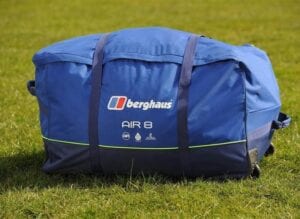
Berghaus Air 8 wheeled carrybag
Even if you found a roofbox large enough, the sheer weight of the Berghaus Air 8 would make you think twice before lifting it above your head.
There are 5 airbeams to inflate, plus a bit of fiddling with the fibreglass poles of the small canopies over the side doors. Pitching time is an optimistic 20 minutes, more realistically you’ll get closer to 25 minutes and you’ll possibly need a hand to help.
Quechua Air Seconds 8.4 F&B
The Quechua Air Seconds 8.4 F&B is as heavy as the Berghaus Air 8 – 30 kgs – but at least the bag is much smaller, only 73 x 38 x 36cm (139 litres). Although it is a two-person lift, but at least it’s possible to chuck it into a roofbox (albeit you’d need a large one, 350 Litres plus) and it does not take up precious boot space like the Berghaus does.
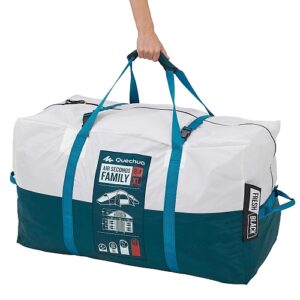
The Quechua Air Seconds 8.4 F&B has 4 air beams, 2 large ones and 2 smaller ones. There’s no estimate on the product page, but I am guessing that pitching can be done in under 20 minutes.
Family Friendliness
It was quite difficult to pick a clear winner…to me, it’s a split 1st place between the Berghaus Air 8 and the Quechua Air Seconds 8.4 F&B. As the Eurohike Genus 800 is the smallest in every aspect, the final order looks like this:
- Berghaus Air 8, Quechua Air Seconds 8.4
- Vango Longleat II 800XL Air
- Eurohike Genus 800
Vango Longleat II 800XL Air
The Vango Longleat II 800XL air tent is the golden mean: not the largest but large enough. Afterall, it’s more than 7 metres long and 2.65 metres wide. The internal headroom is decent, 190 cms almost everywhere within the tent.
Vango tents – especially the budget ones – are usually not very generous on the sleeping space. This is true for the Vango Longleat II 800 XL Air too: there is only 60 cms allocated for one person. The bedrooms can be split into two double rooms or can be opened up and used as a 4-person large bedroom.
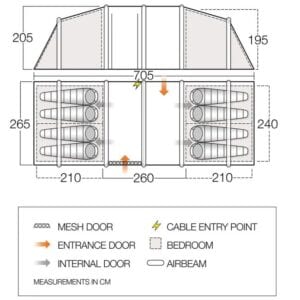
Vango Longleat II Air 800XL floorplan
The living area is not huge either, just shy of 7 square metres but at least you can have a couple of chairs and a table.
In terms of storage and pockets, you have a few in the bedrooms, and there is one cable entry point.
Best Air Tents in 2020
(Round-up post)
The best air tents in every category, for all budgets
Air Tents for 4 Persons
Find the best air tents for couples & small families
Tent Fabrics, Materials
Frequently Asked Questions
If you ever wondered what those numbers mean. With comparison chart.
6-Men Inflatable Tents
if you are on a budget but don't want to compromise on quality...
TOP 5 Air Tents for the Family
Selection of 4-6-berth family tents.
Eurohike Genus 800
The smallest of the four, but how small? The lenght of the Eurohike Genus 800 is just below 6 metres, but it’s as wide as the Vango. Basically, you have the same size sleeping area as you’d have in the Vango Longleat II 800XL air, 60 cms per head, but there is no living room.
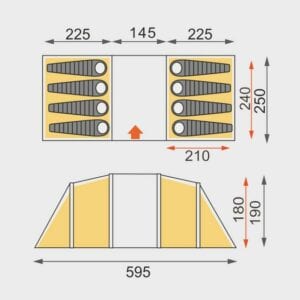
Eurohike Genus 800 floorplan
The length of the living room is only 145 cms, which means the area between the two bedrooms is only 3.6 square metres.
You might call it functional, but if you think of how much gear 8 people can carry, you’d probably come to the same conclusion as I have: the Eurohike Genus 800 is probably too small for a group of 8, purely because there’s no space for the bags, boots etc.
- Eurohike Genus 800 – 6 metres long
- Genus 800 living area from the bedroom – light
- Genus 800 living area – but small
- Genus 800 living area – lots of space…not
I wouldn’t even think about having a couple of camping chairs and a small table in this small living room. On the other hand, let’s not forget about the canopy that you can fit over the entrance. This adds a few extra square metres…I’d say the canopy is definitely a must.
Related post: Eurohike Genus 400 Air Tent Review
Related post: Eurohike Genus 400 Air vs Berghaus Air 4 vs Eurohike Air 400
Berghaus Air 8
I already said how big the Berghaus Air 8 is…well…in numbers it’s 750 cms (length), 300 cms (width) and 70 cms (per head in the bedrooms).
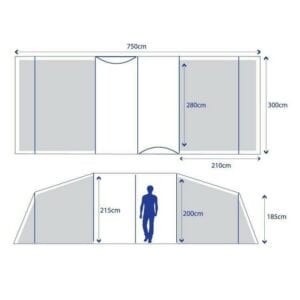
Berghaus Air 8 floorplan
The bedrooms are large, there’s plenty of space, the internal height at the middle of the tent is over 2 metres which makes it feel even more spacious. The headroom is only slightly decreased in the bedrooms to 180 cms, which is still stand-up height for most.

Berghaus Air 8 inner height – I’m 186 cms tall and barely could reach the beam
The living area is huge, you have 10 square metres of space inside. This is more than plenty for camping chairs, table, organiser(s) etc.
The bedrooms are large, but they are not black-out. On later models they use a darkened fabric which – unless the tent is under direct sunlight – do reduce the light inside the bedroom. Earlier models had light colour fabric.
- Berghaus Air 8 bedroom
- Berghaus Air 8 bedrooms
- Berghaus Air 8 storage pockets and air vent
- Toggled divider between the bedrooms
- Half-mesh door on the bedrooms
Quechua Air Seconds 8.4 F&B
Slightly different design, but almost as large as the Berghaus Air 8 – like having a dome with two small sleeping pods.
The tent itself is 740 cms long and 310 cms wide, shorter but wider than the Berghaus Air 8, but internal height at the middle is a stunning 225 cms. The roof then slopes towards the ground and the bedrooms don’t have full stand-up height, the ceiling is only 145 cms above ground level at the back of the bedrooms.
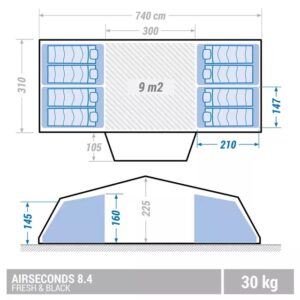
Quechua Air Seconds 8.4 floorplan
The bedrooms are quiet large by the way, the Quechua as the roomiest bedrooms of all four tents. There’s 72.5 cms for everyone to sleep fast in the dark bedrooms.
Related post: Quechua Air Seconds 6.3 XL (Full Review)
The living area does not just feel roomy because of the high ceiling, it is actually large; 9.3 square metres. Only slightly smaller than the Berghaus Air 8’s living room.
- More than 9 sqm living space
- Pre-attached bedrooms that can be taken out – increase the storage space
- Just about large enough
- Almost as big a living area as the Berghaus 8’s
- Large black-out bedrooms
Weather Protection
Vango Longleat II 800XL Air
Vango’s are famous for their robust weather protection – especially their storm protection – system. The Vango Longleat is no exception, it comes with an inner tension bend system called TBS II, which increases the stability of the tent in high winds.
It can be a bit annoying when they are clipped on as they intrude into the headspace of the tent, but the good news is that you can tuck them away when you don’t need them.
As for protection from rain, the Vango Longleat II 800 XL air tent comes with Vango’s Sentinel Active flysheet, which is a 70D polyester fabric. It is a durable and reliable fabric, whilst retaining a compact pack size. Waterproof rated to 3000HH, with taped seams, and it is also UPF30 rated to UV resistance. Your biggest issue probably will be condensation – common problem of modern polyester tents.
Related post: Tent materials, fabrics, specifications and all the acronyms. FAQ.
The Sentinel Active is Vango’s ‘budget’ fabric, so there are better ones within the Vango range and elsewhere.
The groundsheet is sewn in, plus it is attached to the flysheet with an external storm skirt to give all-round protection.
There is also a footprint and a carpet available separately to protect the groundsheet and increase insulation from the ground.
Eurohike Genus 800
There is very little information about the fabrics used on Eurohike Genus 800, or anything regarding weather protection.
The flysheet is made of polyester and has a 3000 mm HH rating, but judging by the weight of the tent the fabric must be thinner than the 70D Sentinel Active fabric on the Vango Longleat II 800XL. (The previous generation Airgo Air Genus 800 had a 68D polyester flysheet.)
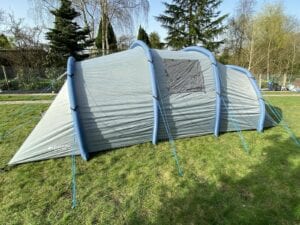
Eurohike Genus 800 with an unknown flysheet
The groundsheet is loose / toggled, so you can roll it up entirely. The bedrooms therefore sit on the ground, their bottom is made of the same material as the groundsheet.
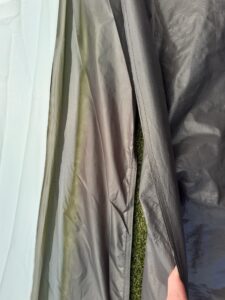
Eurohike Genus 800 – loose groundsheet. This is how it looks like where the groundsheet meets the flysheet
Besides condensation, you will probably need to be aware of insects coming into the tent through the gap between the flysheet and the bedrooms, so it is essential to get a decent bug zapper, or other means of keeping the bugs out.
Berghaus Air 8
The Berghaus Air 8 plays in a different league, being the flagship model (but at least the largest) of the Berghaus range.
The polyester flysheet is has a 6000mm HH waterproof rating, the groundsheet is fully sewn-in, all seams are taped.
- Berghaus Air 8 with the rainhood – just at the right height for me to hit my head every time
- Air vents on the Berghaus Air 8
The side doors have a small rainhood above them, that makes the it possible to leave the door slightly open (or have the mesh part only) even when it rains. On the other hand, I’m 186 cms tall and I kept banging my head into these rainhoods and I found them rather annoying. It’s one thing I need to bend slightly when I enter the tent, but to hit my head every time…anyways, it may be just me being clumsy.
Related post: Berghaus Air 6 XL Inflatable Tent Review
There are various air vents to keep a steady airflow across the tent. Despite that, condensation is still something that you can expect, but otherwise the Berghaus Air 8 is sound.
Quechua Air Seconds 8.4 F&B
Quechua does not provide the ‘usual’ information for any of their tents, so I can’t tell you the waterproof rating of the flysheet for example. What is known that it can withstand 200 Litres of water every hour per square metre – so it’s waterproof – but the other tents probably can do the same trick.
Just to put it into context: a normal garden water sprinkler uses up about 7-8 litres of water every MINUTE, let’s say 450 litres an hour. That amount of water covers, well anything from 10 to 100 square metres depending on the water pressure but if I say 50 square metres, that means it’s 9 Litres of water per square metre per hour. So 200 Litres per sqm/hour is a lot of water.
On the other hand, 2000mm HH means that the fabric can withstand a water column of 2 metres every square centimetre.
The Quechua Air Seconds 8.4 underwent wind tunnel testing as well, and Quechua claims it can withstand Force 7 winds.
Related post: Best Air Tents in Wind
The biggest downside is the loose groundsheet, which is quite unusual in this price category.
Related post: Best Air Tents with Sewn-in Groundsheet
The final order for Weather Protection
So it’s a bit subjective, and I must emphasise that all 4 tents provide adequate protection from the elements. The Berghaus brings what’s expected at this price range, but it does not have any inner tension system etc. The Eurohike Genus 800 is at the other end, but it is a bit unfair as the Eurohike Genus 800 never wanted to compete against the others in weather protection.
Between the Vango Longleat II 800XL and the Quechua Air Seconds 8.4 I feel that the Vango is the solid choice, thanks to the sewn-in ground sheet, storm skirts, TBS system and the accessories available to protect the groundsheet. I put the 8-person Berghaus before the Quechua Air Seconds solely because of the loose groundsheet of the latter.
- Vango Longleat II 800XL Air
- Berghaus Air 8
- Quechua Air Seconds 8.4 F&B
- Eurohike Genus 800
Price
What the Eurohike lost in the previous sections, gains it back in this category. It is by miles the cheapest on the list, in fact, you can almost buy three Eurohike Genus 800 air tents for the price of the others.
- Eurohike Genus 800 – currently for £249 at GoOutdoors
- Vango Longleat II 800XL Air – currently for £629 at Winfields Outdoors
- Quechua Air Seconds 8.4. F&B – currently for £649 at Decathlon
- Berghaus Air 8 – currently unavailable at Millets, Berghaus Air 6 is available for £660 at Blacks
What can alter this comparison slightly is the warranty period for each: the Eurohike Genus 800 and the Berghaus Air 6 does not have any warranty information available. I am guessing there must be a 1 year limited warranty if you register your product, otherwise it is a standard 28 days return.
The Vango Longleat comes with 2 years as standard, plus 1 year if you register on the Vango website too.
The Quechua Air Seconds 8.4 comes with a standard 5 year warranty.

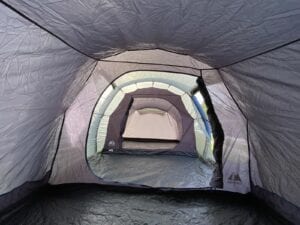
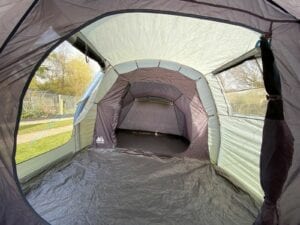
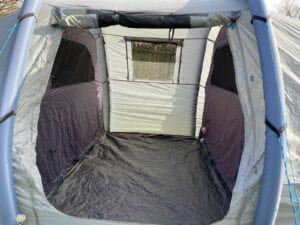
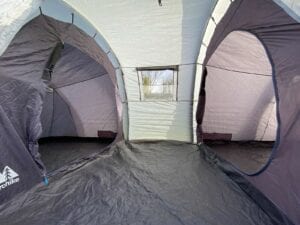

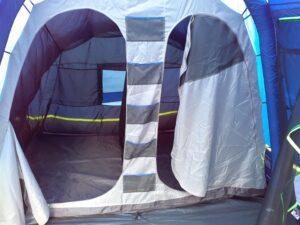
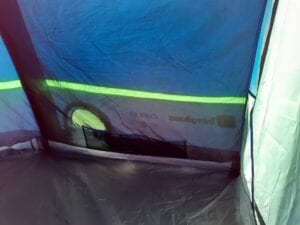

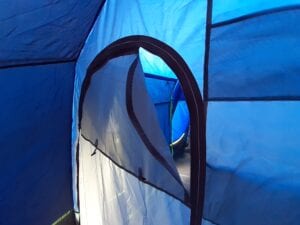
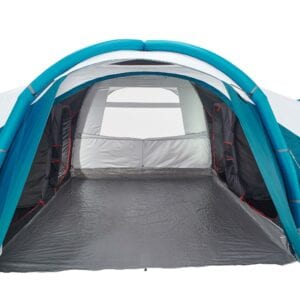

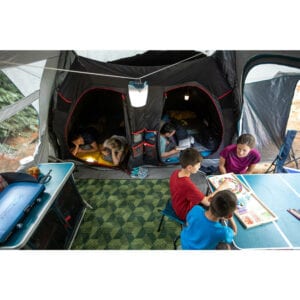
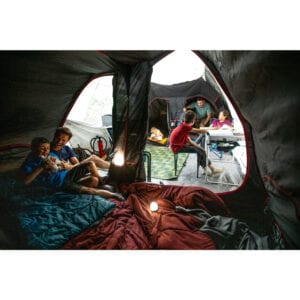
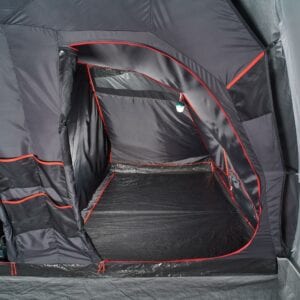
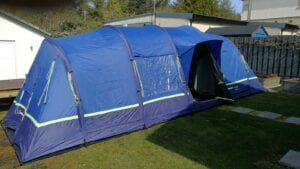
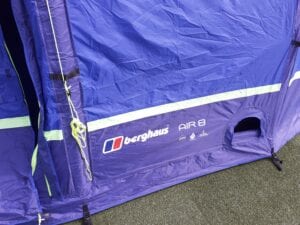
Have to say I’m on season three of using the air seconds 8.4 and love it. Regards weather… living in northern Ireland and using it all year round it’s been hit with 40+ mph winds and floods of rain that hard half the camp site was under water and yet the dome did not bend and inch and not a drop of water came into the bedroom or living area.but you so have to make sure the outer pegs are tight for in high winds with water the outer skin could touch the inner bedroom and maybe cause water issues. I definitely recommend this tent especially for windy weather as I have seen other air beam tents buckle and this one not budge. One of my best buys
Hi Ciaran,
Yes it’s quite impressive what these tents can withstand in terms of severe weather. I think I mentioned the weather testing that all Quechua air tents go through. What you said about pegging out properly and about the flysheet touching the inner tent are probably the same for every tent. Thanks for your comment!